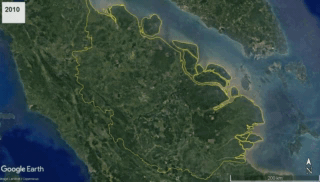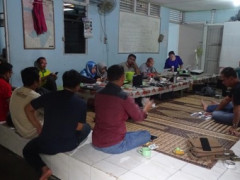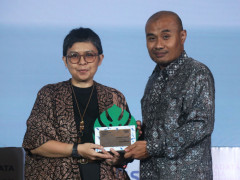Synergy in West Kalimantan Regional Consultation
By Simpul Jaringan Kalimantan BaratTree Adoption: Observing the Riau Government's Effort to Save the Forests

The village community will receive IDR 200,000 for planting a tree with a diameter of more than 40 centimeters. If the diameter is less than 40 centimeters, they will receive IDR 50,000 per tree. The incentive will be given every year. Communities who apply for the program will be assessed by a team from the Riau Environment and Forestry Office. The assessment team will also check the trees to be adopted in the program.
"We hope that the Green Riau program can provide many benefits to people's lives," said Syamsuar through a press release. He added that the program is expected to provide economic, socio-cultural, and environmental benefits for the community.
Even though it has just been launched, IDR 2 billion has been collected from various corporations, including oil palm companies. So far, 10,613 trees have been adopted. “From the 10,613 trees that have been adopted, we receive IDR 200,000 per tree, which means that more than IDR 2 billion has been collected,” said Syamsuar. He explained that the target is for more than 28,000 trees to be adopted by various corporations, including oil palm, as well as oil and gas companies. The Ministry of Environment and Forestry also played a role.
Citing the Riau Government's website, Head of the Riau Environment and Forestry Office, Mamun Murod, said the program is for communities that have already received a Social Forestry permit. Communities participating in the program to protect the Social Forestry area will receive compensation funds. "The funds can also be used for infrastructure and education in the local communities," he said. Mamun added that people will be more eager in protecting trees if they can earn money from them.
The Environment and Forestry Office collaborates with Adopsi Pohon Riau (Riau Tree Adoption Foundation) to manage the platform. Harry Oktavian, supervisor of the Adopsi Pohon Riau Foundation, said that the platform is a strategy to connect the public with companies that want to contribute to tree adoption. The government cannot accept money from the private sector, so a liaison is needed. Adopsi Pohon Riau pools the funds and then channels them to community groups who will manage the Social Forestry programs, such as village forest, customary forest, and community forest. The platform also provides an estimate of the carbon sequestered per one adopted tree.
"Funds from carbon trading in the city are given to the villagers who protect the forests," said Harry.
There are four Social Forestry areas that carry out the tree adoption program. All of them are forests with mineral soil which will be developed into peat or mangrove forests. However, the calculation of carbon in mineral soils does not apply in peat or mangrove Social Forestry areas. "The carbon in peat soil is not calculated as in mineral soil," said Harry.
He added that the carbon in mangrove forests is calculated based on the size of the area. "We will use the same calculation method for peatlands. The procedure is currently being prepared," he said.
Harry denied that this program is being used by certain companies to build their image. He said tree adoption cannot be associated with other things the companies did outside the program. It is a different story if the company is problematic. "See this program as an effort to optimize the role of the public or anyone else to save Riau forests," he said.
Pantau Gambut browsed the map page on the platform and saw that some coordinate points for the tree adoption were in the middle of oil palm plantations. According to Harry, there might be an overlapping error with the map, so it is necessary to re-check the data accuracy. "It's impossible for adopters to adopt trees inside oil palm plantations," he said.
The data page showed that there were 2,179 adopted trees when we accessed the platform on Friday, 24 September 2021. That number had not changed when we checked again on Monday, 25 October 2021. All the trees are in the customary forests of Ghimbo Pomuan Bonca Lida Kenegerian Kampa, and Imbo Putui Kenegerian Petapahan. Some trees are located in the Forest Management Unit (KPH) area, i.e. Sultan Syarif Kasim and Suligi Batu Gajah Forest Parks.
Forest cover continues to decrease
The total area of Riau's forests in 2019 was 8,964,880.21 hectares. The data from the Ministry of Environment and Forestry includes protected forest areas, converted production forests, and areas for other uses. From 2012 to 2019, the forest cover loss in Riau was 781,941.84 hectares.
Pantau Gambut observed that the area of Riau's peat forest cover in 2011 was 3,867,400.48 hectares. The forest cover area has continued to decrease for eight years. In 2019, Riau's peat forest cover was 3,565,502.56 hectares. This means that forest cover has decreased by 301,897.92 hectares.
Mineral and peat soil forest degradation in Riau is more common in concession lands. The World Resources Institute (WRI) Indonesia noted that there were 4,058 fires detected in 2016. Even though the rainfall was quite high that year, it still wasn’t enough to wet Riau forests. The hotspot alert data in 2016 showed a continuous pattern in Riau that 47 percent of fires occurred in wood fiber concession areas.
Unclear Social Forestry management by the government
Coordinator of Simpul Jaringan Pantau Gambut Riau, Romes Irawan Putra, viewed tree adoption as a good initiative. However, Romes also highlighted that the program is related to peat and forest protection in Social Forestry area. "We can't rely on this program alone, especially if it is part of the success of Green Riau," he said.
According to Romes, managers of the Social Forestry area are not only facing the problem of obtaining the budget but also the implementation procedure. "Look at the issued Social Forestry permits, none of them are in the implementation stage," he said. He added that massive illegal logging is still taking place in the Social Forestry area. "Law enforcement to eradicate illegal logging networks must be prioritized," said Romes who is also the Director of Kaliptra Andalas.
From 2008 until now, there has not been a single Social Forestry area that is in the implementation phase. This proves the lack of local government assistance and policy interventions to support the process. Romes said forest fires and peat drainage are also critical problems that we need to solve. The local government should urge the Industrial Plantation Forest (HTI) and oil palm companies to carry out a wetting program in their work areas.
"The government should not only focus on running the Social Forestry program but ignore peat degradation in company concession areas," he said.
Romes also reminded the government to disclose the supervision carried out on peat restoration program in concession areas. “The concessions have drained a huge expanse of peatlands,” he said.
.jpeg)




